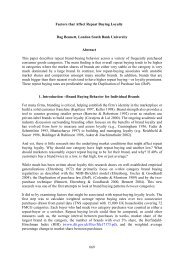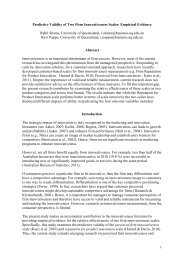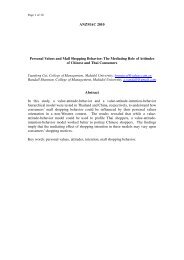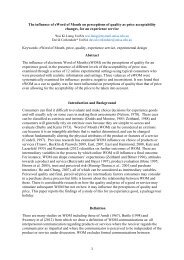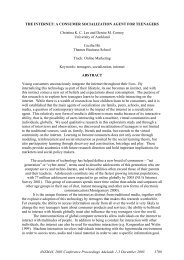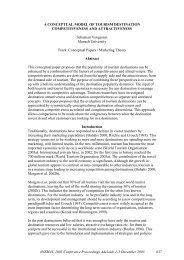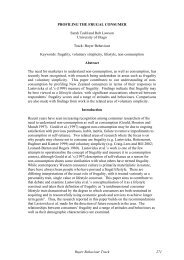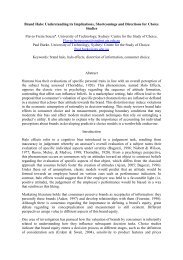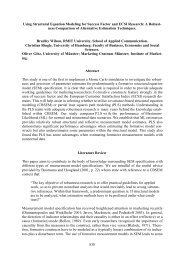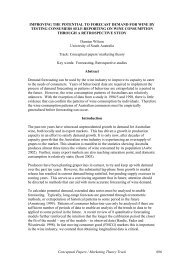Building Friendships and Relationships: The Role of ... - anzmac
Building Friendships and Relationships: The Role of ... - anzmac
Building Friendships and Relationships: The Role of ... - anzmac
Create successful ePaper yourself
Turn your PDF publications into a flip-book with our unique Google optimized e-Paper software.
Background <strong>and</strong> Purpose<br />
<strong>The</strong> service encounter is both ‘social’ <strong>and</strong> ‘communicative’ (Sparks, 1994). <strong>The</strong> social nature<br />
<strong>of</strong>, <strong>and</strong> physical contact in the service encounter promotes intimacy (Goodwin & Frame,<br />
1989; Czepiel, 1990; Goodwin & Smith, 1990), which encourages friendly conversation<br />
between service employee <strong>and</strong> customer. <strong>The</strong> social nature <strong>of</strong> the service encounter can be<br />
attributed to the physical contact required, particularly in ‘people-processing’ services<br />
(Lovelock et al., 2007). Such services involve tangible actions directed at a person (‘high<br />
touch’), requiring the customer to be physically present during service delivery (Lovelock et<br />
al., 2007). ‘People processing’ is characterized by service customization, continuous<br />
relationships <strong>and</strong> high levels <strong>of</strong> customer contact (Lovelock, 1983). Moreover, given they are<br />
required to be physically present during the performance, there is significant involvement <strong>of</strong><br />
customers in the service process (Grönroos, 2000; Lovelock et al., 2007). Using a typology <strong>of</strong><br />
service encounters based on duration, affective content <strong>and</strong> spatial proximity, proposed by<br />
Price et al (1995), people processing service encounters are likely to fall into the extended,<br />
affective, intimate (EAI) category. Although Price et al., (1995) regard hairdressing as ‘low<br />
affect’, findings in this paper suggest it is actually ‘high affect’, dem<strong>and</strong>ing exchange<br />
qualities more likely to be associated with a friendship that engenders the building <strong>of</strong> a long<br />
term relationship.<br />
In this paper, the role <strong>and</strong> importance <strong>of</strong> conversation in eight hairdressing service encounters<br />
is examined from a customer perspective. Analysis <strong>of</strong> these conversations sought to<br />
underst<strong>and</strong>: variations in conversation between ‘short’ <strong>and</strong> ‘long term’ customers, how<br />
conversations contribute to ‘commercial friendships’ <strong>and</strong>; how relationships develop.<br />
Review: Conversation, Service Relationship <strong>and</strong> Friendship<br />
<strong>The</strong> definition <strong>of</strong> conversation used in this paper derives from a communications perspective:<br />
‘<strong>The</strong> continuing social process (Allen & Guy, 1974) where two socialized <strong>and</strong> co-present<br />
persons (Turnbull, 2003) engage in any interactive, spoken exchange with one another’<br />
(Pridham, 2004). Hairdressing is a ‘people-processing’ encounter where conversation is likely<br />
to play an important role. Solomon et al., (1985) state that hairdressing is characterized by a<br />
high degree <strong>of</strong> person-to-person interaction <strong>and</strong> the physical contact may create both intimacy<br />
<strong>and</strong> a closeness that decreases the perceived social distance between the service employee <strong>and</strong><br />
customer (Goodwin & Frame, 1989; Czepiel, 1990; Goodwin & Smith, 1990). This intimacy<br />
<strong>of</strong>ten encourages conversation between the service employee <strong>and</strong> customer. Butcher et al.,<br />
(2002) assert that the hairdresser is constantly within the customer’s personal space.<br />
Similarly, Price & Arnould (1999) argue that hairdressing “throws two people together for a<br />
relatively lengthy period <strong>of</strong> time… both parties are ‘held captive’ to the encounter” (p. 47). In<br />
such a situation, discussing conversation topics unrelated to the immediate service context can<br />
be a strategy for creating verbal ‘closeness’ or immediacy between the service employee <strong>and</strong><br />
customer (Ford, 1998).<br />
Services are inherently relational in nature (Grönroos, 2000). Czepiel (1990) emphasizes that<br />
relationships in services are important given “the social nature <strong>of</strong> service encounters, the<br />
active <strong>and</strong> <strong>of</strong>ten face-to-face interaction between service provider <strong>and</strong> client [<strong>and</strong>] the



